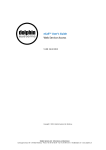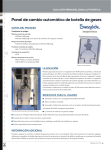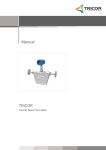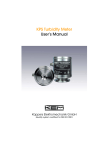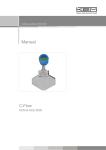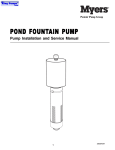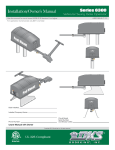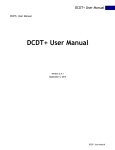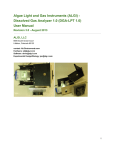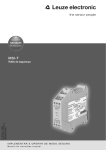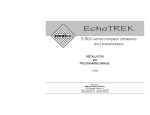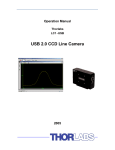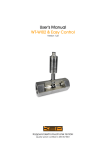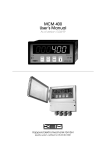Download Manual C-Flow Coriolis Mass Flowmeters with KCE6000
Transcript
Certified according to DIN ISO 9001 Manual C-FLOW with KCE6000 electronics Coriolis Mass Flow Meter SW-Version Main: V2.0x Display: V2.0x Manual-Revision: See rear cover Index 1 GENERAL INFORMATION ..................................................................................................................... 5 1.1 1.2 1.4 FEATURES ........................................................................................................................................................ 5 SAFETY ........................................................................................................................................................... 7 1.2.1 General Safety ............................................................................................................................. 7 1.2.2 Special requirements for Ex installations .................................................................................... 7 1.2.3 Warnings in this manual ............................................................................................................. 8 ORDERING CODES AND ACCESSORIES .................................................................................................................... 9 1.3.1 Ordering Code ............................................................................................................................. 9 1.3.2 Accessories ................................................................................................................................ 10 MEASURING PRINCIPLE KCM ............................................................................................................................ 10 2 GETTING STARTED ............................................................................................................................ 11 2.1 2.2 2.3 2.4 UNPACKING ................................................................................................................................................... 11 OPERATING ELEMENTS..................................................................................................................................... 12 PIN ASSIGNMENTS .......................................................................................................................................... 13 QUICK START ................................................................................................................................................. 14 2.4.1 First Operation .......................................................................................................................... 14 2.4.2 Manual control .......................................................................................................................... 14 3 INSTALLATION .................................................................................................................................. 15 3.1 3.3 MECHANICAL ................................................................................................................................................. 15 3.1.1 Installation Guidelines ............................................................................................................... 15 3.1.2 Horizontal Installation............................................................................................................... 16 3.1.3 Vertical Installation ................................................................................................................... 16 3.1.4 Installation in a Drop Line ......................................................................................................... 17 3.1.5 Critical Installations .................................................................................................................. 17 ELECTRICAL INSTALLATION ................................................................................................................................ 18 3.2.1 Power Supply and Grounding .................................................................................................... 20 3.2.2 Connecting the control inputs and outputs ............................................................................... 20 3.2.3 Connecting the analog output .................................................................................................. 21 EX INSTALLATION ............................................................................................................................................ 21 4 MANUAL OPERATION ....................................................................................................................... 22 4.1 4.2 4.5 4.6 MANUAL CONTROL ......................................................................................................................................... 22 SETUP GUIDELINES .......................................................................................................................................... 22 4.2.1 Meter Mode .............................................................................................................................. 22 4.2.2 Meter Mode .............................................................................................................................. 22 4.2.3 Offset Calibration ...................................................................................................................... 22 4.2.4 Flow filter .................................................................................................................................. 22 4.2.5 Cutoff ........................................................................................................................................ 23 4.2.6 Step response ............................................................................................................................ 23 4.2.7 Interaction of the parameters ................................................................................................... 24 OFFSET CALIBRATION ..................................................................................................................................... 24 I/O SETTINGS ................................................................................................................................................ 25 4.4.1 Frequency Output ..................................................................................................................... 25 4.4.2 Control Output .......................................................................................................................... 25 4.4.3 Analog Output ........................................................................................................................... 25 4.4.4 Control Input ............................................................................................................................. 26 DATA CONFIGURATION ..................................................................................................................................... 26 I/O TEST ....................................................................................................................................................... 26 5 REMOTE OPERATION ........................................................................................................................ 27 5.1 RS485 ......................................................................................................................................................... 27 5.1.1 Electrical connection of RS‐485 ................................................................................................. 27 5.1.2 RS485 Interface Protocol ........................................................................................................... 27 1.3 3.2 4.3 4.4 3 Index 5.2 USB INTERFACE ............................................................................................................................................. 27 5.2.1 Electrical connection of USB ...................................................................................................... 27 6 SERVICE AND MAINTENANCE ............................................................................................................ 28 6.1 6.2 6.3 6.4 6.5 6.6 MAINTENANCE ............................................................................................................................................... 28 TROUBLE SHOOTING ........................................................................................................................................ 28 CHANGING THE FUSES ...................................................................................................................................... 29 CALIBRATION ................................................................................................................................................. 29 SERVICE ........................................................................................................................................................ 29 RELOADING FACTORY SETTINGS ......................................................................................................................... 29 7 LISTINGS ........................................................................................................................................... 30 7.1 7.2 7.3 WARRANTY ................................................................................................................................................... 30 CERTIFICATIONS AND COMPLIANCES.................................................................................................................... 30 TECHNICAL DATA ............................................................................................................................................ 32 7.3.1 Technical Data KCM Transducer ............................................................................................... 32 7.3.2 Technical Data KCE 6000 Transmitter ....................................................................................... 33 7.3.3 Dimensional Drawings .............................................................................................................. 34 WEEE AND ROHS .......................................................................................................................................... 35 LIST OF FIGURES .............................................................................................................................................. 35 ADDRESSES .................................................................................................................................................... 35 7.4 7.5 7.6 4 General Information 1 General Information 1.1 Features The C-Flow Mass Flow Meters based on the Coriolis principle show many advantages compared to other flow meter principles: No moving parts High accuracy Simultaneous measuring of mass flow, density and temperature Calculation of volume flow as well as mass and volume total Flushable The C-Flow Mass Flow with KCE6000 electronics are for applications where due to cost or place restrictions no local display can be used. C-Flow mass flow meters with KCE6000 electronics are available as standard version as well as Ex certified for hazardous locations zone 2. For applications in zone 1 refer to the KCE8000 electronics. The meters provide the following features: 1 freely programmable 4-20 mA outputs 1 freely programmable frequency output 1 to 2 control inputs and 1 control output RS485 interface USB interface (option) The optional KRD8000 remote displays provide the following features: A graphic display Menu driven control with soft keys for easy operation also without manual 5 General Information … Fig. 1: KCM3000 with KCE6000 and remote diisplay KRD8001 6 General Information 1.2 1.2.1 Safety General Safety All statements regarding safety of operation and technical data in this manual will only apply when the unit is operated correctly in accordance with this manual. The data for Ingress Protection will only apply when all connectors are caped properly with the corresponding counterpart with the same or better IP rating. Cable glands must be populated with cables with the specified diameter and closed properly. The display cover must be closed. During operation all openings of the housing must be closed unless otherwise noted in this manual. All connections to the load and to the supply must be made with shielded cables unless otherwise noted in this manual. This unit must be grounded. As a protection against fire in the positive supply a fuse with a current rating not higher than the current carrying capacity of the cable used is required. Before installing the flow meter and transmitter the user is responsible to ensure that all wetted parts are compatible with the fluid or gas to be measured. The user has to adhere to the instructions for installing electrical devices and corresponding instructions. The devices described in this manual may only be connected and operated by authorized and qualified personnel. 1.2.2 Special requirements for Ex installations In hazardous locations the covers of the KCE6000 must not be opened under any circumstances if the supply voltage is alive. The connector to the KCE6000 must not be connected or disconnected with any I/O signal or the power supply alive. When using long cables make sure that the maximum inductances and capacitances for the respective voltage or gas group are not exceeded. The maximum values specified in chapter 7.3must be observed at any time. 7 General Information 1.2.3 Warnings in this manual NOTE: Notes provide important information for the correct usage of the equipment. If the notes are not observed, a malfunction of the equipment is possible. WARNING! Warnings provide very important information for the correct usage of the equipment. Not observing the warnings may lead to danger for the equipment and to danger for health and life of the user 8 General Information 1.3 Ordering Codes and Accessories 1.3.1 K K K K C C C C Ordering Code M M M M 0 0 1 3 3 6 5 0 0 0 0 0 0 0 0 0 Flow range 3 - 300 kg/h 6 - 600 kg/h 15 - 1500 kg/h 30 - 3000 kg/h D A D B Electronics Compact version with KCE6000, I/O5, RS485 Compact version with KCE6000, I/O8, RS485, USB Material high pressure, SS316Ti housing H D B Rupture disk none rupture disk R F Process connections BSP female thread ½ " Process connections BSP ½" P N n n n Pressure rate pressure rate (nnn bar) 3 electr. Connection compact version Junction box Ex protection no Ex protection ATEX Ex, zone 2 Exn K C M 0 3 0 0 - D B - H D B - R F - ½ " - P N 2 0 0 - 3 - E x KCM0300, 3 – 300kg/h, KCE6000 with I/O8 and USB, 200bar operating pressure, Ex protected Please ask KEM or your nearest dealer for the possible combinations and the best solution for your application. 9 General Information 1.3.2 Accessories Ordering Code Description KRD8001 Additional remote display (Contact KEM) Connecting Cable KCE6000 KRD8001 1.4 Measuring Principle KCM Two parallel flow tubes inside the KCM low meter are vibrating at their resonant frequency in opposite direction. Any mass flow passing through the tubes will delay the vibration at the incoming side and accelerate the vibration at the outgoing side. This causes a small time delay between both ends of the tube. This time delay is measured and used to calculate the mass flow through the tubes. By measuring the resonant frequency of the tubes the mass of the medium and - given a constant volume inside the tubes - the specific gravity of the medium can be calculated. As both effects are temperature dependent, the temperature is measured via a precise sensor for correcting the temperature effects of flow and density measurement. As a consequence a coriolis mass flow meter measures directly mass flow, density and temperature of the medium. Knowing the mass flow and the density, also the volume flow can be calculated. Movement to the inside no flow Movement to the inside Fc direction with flow Fig. 2: Flections of the tubes with and without flow 10 Movement to the outside no flow and Movement to the outside Fc direction with flow Getting Started 2 Getting started 2.1 Unpacking Verify that you have received the following items: KCMxxxx… with mounted electronics User’s manual 11 Getting Started 2.2 Operating Elements 3 2 1 8 7 4 5 6 Fig. 3: Operating Elements 1 = Connector RS485, M12, B coded, female 2 = Connector USB, M12 3 = Connector I/O, M12, A coded, male, 8 pin 4 = Connector I/O, M12, A coded, male, 8 pin 5 = Fluid input 6 = Screw for protective ground (KCM0300 through 3000 only) 7 = Fluid output 8 = M6 mounting threads (back side, option) 12 Getting Started 2.3 Pin Assignments I/O5 pinning 1 + 24 VDC Positive supply voltage (24 VDC) 2 I out Current output 4-20mA, referred to GND 3 GND Ground 4 F out Frequency / pulse output 5 CTL IN 1 Control input 1 I/O8 pinning 1 + 24 VDC Positive supply voltage (24 VDC) 2 I out Current output 4-20mA, referred to GND 3 GND Ground 4 F out Frequency / pulse output 5 CTL IN 1 Control input 1 6 CTL IN 2 Control input 2 7 CTL OUT Control output 8 n. c. Not connected RS485 pinning 1 + 24 VDC Positive supply voltage (24 VDC) 2 - RS485 RS485 negative line 3 GND Ground 4 +RS485 RS485 positive line 5 n. c. Not connected 13 Getting Started 2.4 Quick start WARNING! As for safety and accuracy reasons many precautions must be taken, read chapter 3 carefully before installing the unit! In case the unit has only to be operated without flow for testing or learning purpose, the following connections have to be made (see chapter 3.2): Connect the supply voltage Connect the frequency and / or the analog outputs as well as the interface. WARNING! If the unit is connected to a bigger system, for your personal safety connect the protective ground as well! In hazardous areas it is not allowed to operate the unit without proper wiring according to chapter 3.3 and with the housing not properly closed! 2.4.1 First Operation If not ordered otherwise, the standard settings ex factory are as follows: I out: flow, 20mA = specified KCM range F out: flow, 5000 Hz = specified KCM range CTL OUT: fault (I/O8 only) CTL IN 1: make zero CTL IN 2. Reset batch (I/O 8 only) Make sure that all mechanical and electrical connections are made properly. Switch on the power supply. The KCM should slightly vibrate. If a KRD8000 is connected, it will show the power up sequence (see manual KRD8000)) Switch on the flow. The output should show the corresponding values. As soon as the unit has reached the operating temperature, make the zero point calibration (see chapter 4.3Fehler! Verweisquelle konnte nicht gefunden werden.): 2.4.2 Switch off the flow Wait until the flow is zero Start the zero point calibration by applying a low to CTL IN 1 Wait until the offset procedure is finished (about 10 seconds) Switch on the flow again Manual control For manual control a remote display KRD8000 is required. See the manual KRD8000 for a description of the manual control 14 Installation 3 Installation 3.1 Mechanical In accordance with this manual the user should select the installation position which fits the application best. To ensure the highest degree of accuracy and repeatability, care should be taken to affix the C-Flow products in a stable process site and minimize the amount of vibration in the installation environment 3.1.1 Installation Guidelines Coriolis mass flow meters measure the flow of a liquid or gas by vibrating the medium perpendicular to the flow direction and measuring the effect of the inertial force of the medium. Consequently for best performance the meter must be decoupled from external vibrations and the medium must be homogenous. External vibration: In case of (possible) external vibrations connect the meter mechanically rigidly to a non-vibrating point or – if this is not possible – connect it via vibration dampers. The meters can be mounted via optional mounting threads on the back side. In case of vibrating tubes a decoupling via flexible hoses might be recommended. Piston pumps and other pumps producing a strongly pulsating flow should be decoupled hydraulically via longer pipes, flexible tubes or other measures. Inhomogeneous media: If a liquid might contain gas bubbles or solid particles, care must be taken that the gas bubbles or the solid particles will not remain in the meter. If a pure liquid or a liquid with possible gas bubbles is to be measured, the meter should be installed horizontally with the meter showing downwards. This assures that gas bubbles will not accumulate in the measuring tubes. If a liquid might contain solid particles, the meter should be installed horizontally with the meter showing upwards. This assures that the solid particles will not accumulate in the measuring tubes. The meters must not be mounted vertically, as according to the diamond shaped tube geometry gas bubbles as well as solid particles would accumulate in the meter. 2 phase media with gas bubbles (like foam) or solid particles (like paints or slurry) can be measured without any problems, if the gas bubbles or solid particles are small compared to the tube diameter and evenly distributed. The mounting guidelines, nevertheless, must be observed. 15 Installation 3.1.2 Horizontal Installation The horizontal installation is the recommended installation. If the medium might contain solid particles, mount the meter as in position “A”, in all other cases as in position “B”. Fix the meter to a solid, non-vibrating surface as close to the meter as possible. This could be done via the optional mounting threads. If no non-vibrating surface is available, vibration dampers might be recommended. Fig. 4: Recommended Horizontal Installation 3.1.3 Vertical Installation A vertical installation should only be selected, if a) the medium contains no deposits. b) gas or air bubbles are not expected. Please consider that the KCM0300 through KCM3000 will not run empty in this position due to the geometric construction of the measuring tubes. When the system is stopped gas or air bubbles may accumulate at the highest point of the tubes. Due to the tube geometry the measuring tubes do not vent automatically in vertical installation position. Gas bubbles may also accumulate at the highest point of the tubes when the mass flow is very low. Generally, gas bubbles will lead to undefined measuring results due to the big density difference. Fig. 5: Vertical Installation 16 Installation 3.1.4 Installation in a Drop Line If a meter must be mounted in a drop line, an orifice and the closing valve are to be located below the meter for making sure, that neither during operation nor after closing the valve the meter will run empty. Fig. 6: Installation in a Drop Line 3.1.5 Critical Installations The meters must not be mounted at the highest point of the tubing, if gas bubbles are to be expected (A), or at the lowest point, if solid particles are to be expected (B), as in both cases also the right orientation might not help. Also the meters must not be mounted in a drop line near the open end (C), as in that case the meter might run empty. Fig. 7: Critical Installations 17 Installation 3.2 Electrical installation Make sure that the unit is properly mounted and the process input and output are connected before making the electrical connections. This unit must be grounded. The KCE requires a regulated DC power supply of 24V ±20%. The digital inputs and outputs are referred to GND and to the ground potential of the DC supply (= negative pole). The ground potential GND is connected to protective ground via a 1kΩ. For connecting the KCE, shielded cables must be used. The shield should be connected to the case. If in bigger systems the shield must not present a DC connection for avoiding high ground loop currents, make the ground connection of the shield via a capacitor of e. g. 100nF. Make sure that the flow meter is grounded. WARNING! Improper grounding and shielding may lead to bad EMC behavior or danger to your health! NOTE Make sure that all cable and wires are connected and fixed properly before applying power to the KCE. All electrical connections have to be done via the M12 connectors. Connect the shields to PE. NOTE: In bigger installations a separate PE connection with a high cross section (> 1.5mm²) is recommended for avoiding high equalizing currents in the shield. Connector pinning I/O8 or I/O5 1 + 24 VDC Positive supply voltage (24 VDC) 2 I out Current output 4-20mA, referred to GND 3 GND Ground 4 F out Frequency / pulse output 5 CTL IN 1 Control input 1 6 CTL IN 2 Control input 2 (I/O8 only) 7 CTL OUT Control output (I/O8 only) 8 n. c. Not connected 18 Installation Fig. 8: Wiring diagram KCE6000 19 Installation 3.2.1 Power Supply and Grounding The KCE6000 requires a regulated DC power supply of 24V ±20%. The power supply input of the KCE is protected by a 315mA fuse. As a protection against fire in case of a short in the supply cable, the output of the power supply must be equipped with a fuse with a rating not higher than the current carrying capacity of the cable used. For connecting the KCE 6000 use shielded cables. If several cables are used, each cable should be shielded properly. The ground pins of connector I/O5, I/O8 and RS485 are internally connected together. The supply pins of connector I/O5, I/O8 and RS485 are internally connected together via ferrite inductances for EMI suppression. For operating the KCE6000, the power supply can be applied to any of the 3 connectors. NOTE The USB interface cannot be used to power the KCE6000. If a remote display KRD8000 is connected, the display will be fed via the RS485 connector. In that case use the connector I/O5 or I/O8 for powering the whole system. See Fig. 8 for connecting the power supply. Ground (GND) and protective ground (PE) are internally connected via a 1kΩ resistor. The resistor will thermally withstand a potential difference of up to 30V between PE and GND but for proper operation this difference should be limited to 5V. 3.2.2 Connecting the control inputs and outputs The frequency and control outputs are active push-pull outputs with an output resistance of 220Ω. They can be loaded to the positive supply or to ground. For a high output swing the load resistors Rload (not shown in Fig. 8) should not be lower than 1kΩ. The digital outputs can drive any normally used input, including PLC inputs. In case of a load resistor to ground the output voltages are: Vhigh = Vsupply * Rload / (220Ω + Rload) Vlow < 1V In case of a load resistor to the positive supply the output voltages are: Vhigh > Vsupply – 1V Vlow = Vsupply - Vsupply * Rload / (220Ω + Rload) The inputs are active low with levels according to IEC946. Due to the internal pull up resistor they can be driven by a push pull output, an npn open collector output or a switch to ground. If for any reason a series resistor Rser is required, the value should be limited to a maximum of 1kΩ for proper operation. See Fig. 8 for connecting the digital inputs and outputs. 20 Installation 3.2.3 Connecting the analog output The KCE6000 provides 1 active 4-20mA current output referred to GND. The minimum load resistance is 0Ω, the maximum is determined by the supply voltage. At a given supply voltage the maximum load resistance can be calculated as: Rload(max) = (Vsupply – 8V) / 22mA For 24V minus 10% supply this gives a maximum value of 620Ω. See Fig. 8 for connecting the analog output. 3.3 Ex Installation WARNING! In hazardous locations all installations must only be carried out by qualified personnel! Switch off all power supplies before installing or uninstalling the unit in hazardous locations! Never connect or disconnect any connector in hazardous locations with any supply or I/O circuits alive! The KCM****-D*-***-**-****-Exn is ATEX specified for operation in zone 2, if powered by an SELV supply. For operation in hazardous areas a good connection of PE is mandatory. The cross section of the PE cable must be at least the cross section of the supply cable or 1mm², whichever is higher. WARNING! Make sure that the maximum voltage, current and power ratings at the inputs and outputs of the KCE6000 are never exceeded! 21 Manual Operation 4 Manual Operation 4.1 Manual control The KCE6000 does not provide any manual control. If a manual control is required, a remote display KRD8000 must be used. For the description of the manual control refer to the KRD8000 manual. 4.2 Setup guidelines This chapter describes how to optimize the meter for a certain application. For changing the settings, the KRD6000 or a remote control is required. 4.2.1 Meter Mode Ex factory the C-Flow mass flow meter come with a setup optimized for normal applications. In more than 90% of the applications no further optimization except a regular offset adjustment is required. The different possibilities for optimizing the settings are described below. 4.2.2 Meter Mode A coriolis mass flow meter measures the mass flow and the density and can calculate the volume flow. For avoiding strange effects with the total values when changing the dimensions, the KCE8000 can be set up as a mass flow OR a volume flow meter. When set up as mass flow meter, only mass and mass flow engineering units can be selected, when set up as volume flow meter, only volume and volume flow engineering units can be selected. 4.2.3 Offset Calibration In contrast to a PD meter, a coriolis mass flow meter has no “natural” zero. At no flow the measured time shift is nearly zero, but not exactly. The offset calibration determines this offset and corrects the measured value correspondingly. As the offset depends slightly upon the temperature, the density of the medium and the operating pressure, it is strongly recommended to make the offset procedure under working conditions, i.e. with the medium to be measured and at operating pressure and temperature. 4.2.4 Flow filter The rough data of a mass flow meter are relative noisy. For having a stable reading a filtering of the calculated flow is required. The filters in the KCE8000 are set via the time constant t. The time constant is the time the output needs after a jump from x to 0 to go to x/e = x/2.72. A higher time constant means more stable reading, but also a slower reaction to changing flows. A rough relation between the time and the filtered flow value after a jump is 22 Manual Operation Elapsed time 1*t 2*t 3*t 4*t Remaining error (% of the step) 30 10 3 1 A linear filter as it is realized in the KCE8000 electronics just delays the flow reading and consequently the total. Independent of the slope (fast or slow) of the rising and falling flow, the error of the internally calculated total and at the frequency output cancel out, if the flow rises from zero (or any other value) and later goes back to the starting value. For getting a correct total via the display or the frequency output, it is just necessary to wait long enough after the flow is switched off. For best results the KCE8000 electronics provide 2 filters. The FLOW FILTER filters the mass flow before calculating other parameters like volume flow, total or the frequency and current outputs. For normal applications a moderate filtering with t = 1s is recommended. The DISPLAY FILTER filters the flow display additionally to the FLOW FILTER. It does not affect any other parameter or any of the outputs. The default setting is t = 1s. If the flow is fast changing or sometimes makes a jump and the outputs have to react as fast as possible, set FLOW FILTER to t < 1s. If nevertheless the flow display has to be stable for better readability, the DISPLAY FILTER can be increased. 4.2.5 Cutoff As mentioned above, a mass flow meter has no natural zero and the rough data are noisy. Consequently with now flow a meter would indicate and give out continuously a small fluctuating flow. The parameter CUTOFF is used to provide a clear zero. If the calculated and filtered flow is below cutoff, the meter indicates zero, the total values remain unchanged and the outputs show zero flow as well. The value for CUTOFF must be above the noise floor in the given application and well below the minimum flow to be measured. As a good compromise the default value for CUTOFF is 0.5% of the full scale range of the meter. 4.2.6 Step response Sometimes it is necessary to react fast to a fast changing flow, but also to have a stable output, if the flow is (mostly) constant. This cannot be achieved by adjusting the flow filter. The parameter STEP RESPONSE provides a fast reaction at fast changing flow, also the filter constant is high. If the difference between the measured flow and the filtered flow is smaller than the step response value, the flow filter remains active. If the difference is higher than step response, the filter is cleared and filled with the new value. The recommended value for constant or slowly changing flow is 99% (the default value ex works). If the unit has to react to fast changing flow, the optimum value depends on the individual situation. For ON / OFF operation a value of half the ON flow is recommended. If STEP RESPONSE is set too low, even small changes in flow or even the internal noise will activate the step response function and partially or all the time deactivate the filter, leading to noisy readings and noisy output signals. 23 Manual Operation 4.2.7 Interaction of the parameters As each of the 3 parameters affects the calculation of the flow in a different way, a bad combination of different parameters can lead to systematical errors. FLOW FILTER and CUTOFF If the filter constant is set to a high value, the calculated flow is delayed compared to the actual flow. In ON-OFF operation this leads to the fact that it takes a long time until the calculated flow settles to the ON or OFF value. The total value remains correct if the unit measures long enough after the flow got switched off. If cutoff is set to a high value, the meters stops measuring too early and consequently the calculated total is too low. Also the number of pulses at the frequency output is too low. The error is systematic. NOTE In ON-OFF operation high values for the flow filter combined with high values for cutoff must be avoided! Jumps of the flow not going down to zero are not affected by cutoff. FLOW FILTER and STEP RESPONSE As described above, a linear filter just delays the flow reading and consequently the total but does not alter the final total. If the step response is activated, a nonlinear term is added to the filter. The indicated flow will follow more closely the total flow, but the remaining deviation depends on the values for the filter and for step response, but also on the slope of the flow change and on the size of a step. If the flow changes slowly or a jump is smaller than step response, the step response function will not be activated and remains linear all the time, producing the normal delay. If the flow changes fast and the step is higher than step response, the filter will be made faster, the indicated flow follows more closely the actual flow and the delay will be smaller. In ON-OFF operation with a fast rising and slowly falling flow a systematic positive error is to be expected. If the rising is slow and the falling fast, the error will be negative. WARNING! If step response is used (e.g. for good reaction to fast changing flow), checking the accuracy for the given application is strongly recommended! 4.3 OFFSET Calibration For best accuracy the C-Flow needs an in situ offset calibration. This calibration zeroes out the ambient effects and increases the measuring accuracy at low flow. The offset calibration must be carried out with the medium to be measured and should be carried out at a temperature and pressure as close to the normal operation as possible. Proceed as follows: Operate the unit for a while under normal operating conditions for making sure that the actual temperature of the unit equals the normal operating temperature. Switch off the flow. For best results use a valve in front and one behind the KCM. If the valves are not close to the KCM and / or only one valve is used, wait long enough for being sure that there is no more flow through the KCM. NOTE: If there is a residual flow through the KCM or the KCM is exposed to mechanical shocks during the offset procedure, the resulting value will be wrong. 24 Manual Operation Start the offset procedure by applying a low level to CTL IN 1 (if CTL IN 1 is configured as “make offset”), via the KRD8000 or via the interface. The offset procedure takes about 10 s (fast) or 25 – 30 s (slow). After the offset procedure reopen the valves and restart the flow. 4.4 I/O Settings The inputs and outputs of the KCE6000 can be used for different purposes. The following chapters give an overview over the possible settings. For changing the settings the KRD8000 or a remote control is required. 4.4.1 Frequency Output The frequency output has 2 operating modes: FREQUENCY: A frequency proportional to the actual flow is generated. If a negative flow must be given out as well, the control output can be used as sign. Frequencies between 2Hz and 10kHz can be generated in this mode. TOTAL COUNT: Each time the total increments by the selected total increment step, the output produces a pulse. For having a 50% duty cycle, the output changes its state each time after half the increment step. If the flow is negative in between, no pulses are generated until the following positive flow compensates for the negative flow in between. Thus the medium will not be counted twice, if in between a flow backwards occur. The maximum output frequency which can be generated in this mode is about 50Hz. 4.4.2 Control Output The control output has 3 operating modes: BATCH: In the batch mode the KCE8000 operates as a batch counter. If the preset batch value is reached, the control output goes to the active state. With an active signal at the control input the batch counter can be reset to zero. For this mode the control input must be configured as “reset batch”. FAULT: In case of an error the control output goes high. FLOW DIREC: The control output is low, if a positive flow is measured, and high, if a negative flow is measured. 4.4.3 Analog Output The analog output can show one of the following 4 parameters: FLOW: The output current is proportional to the actual flow. DENSITY: The output current is proportional to the actual density. TEMPERATURE: The output current is proportional to the actual temperature. BATCH COUNT: The output current is proportional to the actual batch value. This mode is only possible, if the control input is configured as “RESET BATCH” The value for 4mA as well as the value for 20mA can be freely selected. Thus it is possible to zoom in (e.g. temperatures from 20°C to 30°C) or to show negative values as well (e.g. flow from -10kg/min to +20kg/min). 25 Manual Operation 4.4.4 Control Input The control inputs have 2 operating modes: RESET BATCH: If a low level is applied to the input, the batch counter is reset to 0. This mode must be selected, if the control output is to be used as a batch output and / or if one of the analog outputs is to be used as batch output EXTERNAL ZERO: If a high level is applied to the input, the KCE8000 starts the zero offset procedure. 4.5 Data configuration The KCE6000 can store the settings in a backup memory. For storing or reloading the settings the KRD8000 or a remote control is required. 4.6 I/O Test For testing the electrical connections, all inputs and outputs can be tested. The following tests are available: FREQ OUT CTRL OUT ANALOG OUT CTRL IN: A freely settable frequency can be applied to the output The output level can be set A freely settable current can be applied to the outputs The actual level at the input is indicated For making the tests the KRD8000 or a remote control is required. 26 Remote Operation 5 Remote operation As a standard the KCE6000 is equipped with an RS-485 Interface. Optionally a USB interface is available. 5.1 RS485 5.1.1 Electrical connection of RS-485 Connect the signal RS-485A or RS-485+ (both names are used in the literature) to pin 2 and RS-485- or RS-485B to pin 4 of the connector “RS485”. Terminal 3 is the ground reference pin for the interface. The KCE6000 can be powered via the +24V and GND pins of any of the connectors. If the KCE6000 is used via the RS485 and no other I/O signal is used, it can be powered also via pin 1 and 3 of the RS485 connector. NOTE: The operating range of the data pins (2 and 4) is -7V to +12V referred to ground (3). Voltages outside that range could damage the KCE6000. 5.1.2 RS485 Interface Protocol The KCE8000 uses a proprietary KEM communication protocol. The parameters for the serial communication are: 19200 bit/s 8 data bit no parity bit 1 stop bit For setting up a communication refer to the command list available from KEM. 5.2 USB Interface For using the USB interface with a PC, the remote control SW “TRICOR Configurator” for WINDOWS XP, VISTA and WINDOWS 7 is available free of charge. With the Tricor Configurator all settings can be made. Additionally automatic measurements as well as the storage of the measured data and the settings are possible. 5.2.1 Electrical connection of USB The KCE6000 cannot be powered via the USB interface. Therefore a separate 24V supply is required. For temporary connection of the USB interface a normal USB A to MINI USB cable can be used. For a stationary connection in an automatic system the USB A to USB M12 cable available from KEM is mandatory for maintaining the specified IP rating. 27 Service and Maintenance 6 Service and Maintenance 6.1 Maintenance The sensors of the KCM series as well as the electronics of the KCE6000 series do not require regular maintenance. In case of abrasive or sedimenting media however it is recommended to return the measuring system to KEM after 8,000 hours of operation for re-calibration and pressure test. This interval may be shorter when the medium is extremely abrasive or sedimenting. For best performance we recommend checking the calibration every 5 years, in harsh environments even more frequent. If for the specific application an obligatory calibration is required, refer to the corresponding national regulations for the necessary calibration intervals. 6.2 Trouble shooting In case the C-Flow does not work properly, first check the following items: No operation at all All cables properly connected? Connect the missing cables Power supply switched on? Switch on the power supply Internal fuse of the KCE blown? For checking and changing the fuses refer to chapter 6.3. Output frequency too high or unstable Most probably EMC problems Shield and ground properly connected? Connect shield properly. If necessary, try additional means of grounding and shielding Unstable flow reading with (theoretically) stable flow Gas bubbles or solid particles in the medium? Mount the meter with the correct orientation Strong external vibrations? Decouple the meter from the vibration source Flow or pressure slugs in the medium? Decouple the meter hydraulically No frequency or current output with operating display Output correctly wired? Correct the wiring Output correctly configured? Correct the configuration Wrong flow direction (Flow in the display is negative)? Change flow direction 28 Service and Maintenance 6.3 Changing the fuses The power supply input of the non-Ex versions of the TCE6000 contains a fuse. NOTE The Ex versions do not contain fuses The fuse can easily be replaced by qualified personnel: Switch off the power supply. Open the 4 screws in the top cover of the KCE6000. Remove the top cover carefully. Near the lower end of the PCB in the top cover you find the following fuse in the fuse holder: Littelfuse NANO 2 375mA slow blow, ordering code 0452.375 NOTE For your own safety replace the fuse only by the same type and rating. Replace the fuse. Put the top cover carefully on the KCE6000 again and fix it with the 4 screws. NOTE Make sure that the top cover and the gasket in the top cover are at the right position before reaffixing the screws. 6.4 Calibration For calibrating the flow, density and temperature measurement of the KCE6000 the remote display KRD6000 or a connection via interface (e. g. TRICOR Configurator via USB) is required. 6.5 Service The KCE6000 does not contain any user serviceable parts except the fuses. In case of malfunction, please contact your nearest dealer or directly KEM. For the addresses see chapter 7.6. 6.6 Reloading Factory Settings In case the unit has been completely misadjusted for any reason, the unit can be reset to the original settings ex work. For reloading the original settings the KRD8000 or an interface connection is required. 29 Listings 7 Listings 7.1 Warranty KEM warrants material and production for a period of 12 months after installation and start up, max. 18 months from delivery date. 7.2 Certifications and compliances 1 2 Category Standards or description EC Declaration of Conformity EMC Meets intent of Directive 2004 / 108 / EEC for Electromagnetic Compatibility. Compliance is given to the following specifications as listed in the Official Journal of the European Communities: EN 61326 / 2006 EMC requirements for Class A electrical equipment for measurement, control and laboratory use, including Class A radiated and Conducted Emissions1 and Immunity1. IEC 61000-4-2 /2009 Electrostatic Discharge Immunity (Performance criterion B) IEC 61000-4-3 / 2008 Radiated RF Electromagnetic Field Immunity (Performance criterion B) IEC 61000-4-4 / A1-2009 Electrical Fast Transient / Burst Immunity (Performance criterion B) IEC 61000-4-5 / 20072 Power Line Surge Immunity (Performance criterion B) IEC 61000-4-6 / 2009 Conducted RF Immunity (Performance criterion B) IEC 61000-4-11 / 20052 Voltage Dips and Interruptions Immunity (Performance criterion B) Australia / New Zealand Declaration of ConformityEMC Complies with the Radiocommunications Act and demonstrated per EMC 1 Emission standard FCC EMC Compliance Emissions comply with the Clas A Limits of FCC Code of Federal Regulations 1 47, Part 15, Subpart B . AS/NZS 2064 Industrial, Scientific, and Medical Equipment: 1992 Compliance demonstrated using high-quality shielded interface cables Applies only to units with AC mains supply instead of or additional to the SELV supply 30 Listings Category Standards or description EC Declaration of Conformity – Low Voltage Compliance is given to the following specification as listed in the Official Journal of the European Communities: Low Voltage Directive 2006/95/EEC EN 61010-1 / 2002 Safety requirements for electrical equipment for measurement control and laboratory use. U.S. Nationally Recognized Testing Laboratory Listing UL 61010-1 / 2004 Standard for electrical measuring and test equipment. Canadian Certification CAN/CSA C22.2 no. 61010-1-4 / 2008 Safety requirements for electrical equipment for measurement, control, and laboratory use. Additional Compliance IEC61010-1 / 2002 Safety requirements for electrical equipment for measurement, control, and laboratory use. Equipment Type Test and measuring Safety Class Class 1 (as defined in IEC 61010-1, Annex H) – grounded product ATEX II 3G Ex nA IIC T4 Option 31 Listings 7.3 Technical Data 7.3.1 Technical Data KCM Transducer KCM0300 KCM0600 KCM1500 KCM3000 Max. flow (kg/h) 300 600 1500 3000 Min. flow (kg/h) 3 6 15 30 Max. flow (lb/min) 11.0 22.0 55.0 110 Min. flow (lb/min) 0.11 0.22 0.55 1.10 Basic Accuracy (% of flow) 0.1 Zero Stability (% of f. s.) 0.01 Zero Drift (% f.s. per °C) 0.001 Repeatability (% of flow) 0.1 Density meas. range 0 - 4500 kg/m³ Density accuracy ±0.002 kg/ltr. Temperature accuracy ±1°C ±0.5% of reading Process and Ambient Process connections female thread 1/2" adaptors for flanges, diary and tri-clamp Max. pressure Max. pressure (Option) 200 bar 350 bar Pressure Drop at max. flow H20 see diagram Operating Density range 500 - 2500 kg/m³ Process temperature -100 ... +100°C (different ranges) Ambient temperature -20 ... +70°C Storage temperature -40 ... +100°C Ingress Protection IP67 General Tube arrangement 2 serial 2 parallel 2 serial 2 parallel Tube inner diameter 4mm 4mm 8mm 8mm Tube material stainless steel DIN 1.4571 Housing material stainless steel DIN 1.4571 Dimensions 32 see drawings Listings 7.3.2 Technical Data KCE 6000 Transmitter General Supply voltage: 24 VDC, ± 20% Programming: via KRD8000 or via Interface Interface: RS 485, option USB EMC: according to EN 50 081-2 and EN 50 082-2 Power consumption: max. 4 W Connections: M12, A coded, male (I/O, power supply) M12, B coded, female (RS485, power supply) M12 MINI USB Material: aluminum diecast Protection class IP 65 Analog Outputs 1 current outputs: 4-20 mA active, ground referred Resolution: 14 bit Linearity: ± 0.05% of full scale Temperature drift: 0.05% per 10K Load: < 620 Ω (at 24V supply) Output value: flow rate, job total, density or temperature Pulse Output Frequency range: 0.5 -10,000 Hz Output signal: active push pull output of flow rate and / or cycle output Digital I/O Status output type push pull Low / high level 1V / 23V @ 24Vsupply, 10kΩ load Allowed load current 20mA max. Output signal Programmable Control input type Active low, 1 or 2 Threshold voltage 6.5V Input current < 0.5 mA Input signal Programmable 33 Listings 7.3.3 Dimensional Drawings Remote meter Fig. 9: Dimensional Drawing (mm) Sensor Dimensions Type A H C E L G KCM 0300 214 182 160 15 110 ½“ KCM 0600 214 182 160 15 87 ½“ KCM 1500 350 280 258 18 140 ½“ KCM 3000 350 280 258 18 140 ½“ 34 Listings 7.4 WEEE and RoHS The unit described herein is not subject to the WEEE directive and the corresponding national laws. At the end of life forward the unit to a specialized recycling company and do not dispose it off as domestic waste. The unit described herein fully complies with the RoHS directive. 7.5 List of figures FIG. 1: KCM3000 WITH KCE6000 AND REMOTE DIISPLAY KRD8001 ................................................................. 6 FIG. 2: FLECTIONS OF THE TUBES WITH AND WITHOUT FLOW ............................................................................. 10 FIG. 3: OPERATING ELEMENTS ..................................................................................................................... 12 FIG. 4: RECOMMENDED HORIZONTAL INSTALLATION ....................................................................................... 16 FIG. 5: VERTICAL INSTALLATION ................................................................................................................... 16 FIG. 6: INSTALLATION IN A DROP LINE ........................................................................................................... 17 FIG. 7: CRITICAL INSTALLATIONS ................................................................................................................... 17 FIG. 8: WIRING DIAGRAM KCE6000 ............................................................................................................. 19 FIG. 9: DIMENSIONAL DRAWING (MM) ......................................................................................................... 34 7.6 Addresses Headquarter KEM Küppers Elektromechanik GmbH Liebigstraße 5 DE-85757 Karlsfeld Germany Tel.: +49 8131 593910 [email protected] www.kem-kueppers.com 35 Contact Copyright KEM, Subject to change without notice, ES. Rev 001-01.06.2012







































